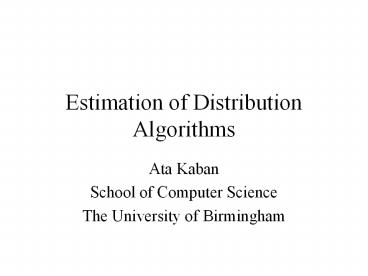Estimation of Distribution Algorithms - PowerPoint PPT Presentation
Title:
Estimation of Distribution Algorithms
Description:
The EDA Algorithm. Step 1: Generate M individuals (the initial ... the EDA results were ... EDA: a new class of EA that does not use conventional ... – PowerPoint PPT presentation
Number of Views:191
Avg rating:3.0/5.0
Title: Estimation of Distribution Algorithms
1
Estimation of Distribution Algorithms
- Ata Kaban
- School of Computer Science
- The University of Birmingham
2
What is EDA
- EDA is a relatively new branch of evolutionary
algorithms - M Pelikan, D.E Goldberg E Cantu-paz (2000)
Linkage Problem, Distribution Estimation and
Bayesian Networks. Evolutionary Computation
8(3) 311-340. - Replaces search operators with the estimation of
the distribution of selected individuals
sampling from this distribution - The aim is to avoid the use of arbitrary
operators (mutation, crossover) in favour of
explicitly modelling and exploiting the
distribution of promising individuals
3
The EDA Algorithm
- Step 1 Generate an initial population P0 of M
individuals uniformly at random in the search
space - Step 2 Repeat steps 3-5 for generations l1, 2,
until some stopping criteria met - Step 3 Select NltM individuals from Pl-1
according to a selection method - Step 4 Estimate the probability distribution
pl(x) of an individual being among the selected
individuals - Step 5 Sample M individuals (the new population)
from pl(x)
4
Typical situation
- Have Population of individuals their fitness
- Want What solution to generate next?
5
(No Transcript)
6
Probabilistic Model
- Different EDA approaches according to different
ways to construct the probabilistic model. - A very simple idea
- - for n-bit binary strings
- - model a probability vector p(p1,...,pn)
- pi probability of 1 in position i
- Learn p compute the proportion of 1 in each
position - Sample p Sample 1 in position i with probability
pi.
7
Note The variables (bits, genes)
are treated independently here. 'Univariate
Marginal Distribution Algorithm' (UMDA)
8
Different EDA approaches
- Independent variables (compute only a probability
vector) - Univariate Marginal Distribution Algorithm
(UMDA) - Population Based Incremental Learning (PBIL)
- Compact Genetic Algorithm (CGA)
- Bivariate Dependencies
- Multiple Dependencies
- Discrete vs Continuous versions
9
How does it work?
- Bits that perform better get more copies
- And get combined in new ways
- But context of each bit is ignored.
- Example problem 1 Onemax
10
Probability vector on OneMax
11
- Compared with GA with one point crossover
mutation
12
- Example problem 2 Subset Sum
- Given a set of integers and a weight, find a
subset of the set so that the sum of its elements
equals the weight. - E.g. given 1,3,5,6,8,10, W14
- solutions 1,3,10,3,5,6,6,8,1,5,8
13
(No Transcript)
14
- Does the simple probability vector idea always
work? - When does it fail?
15
- Example problem 3 Concatenated traps
- - string consists of groups of 5 bits
- - each group contributes to the fitness via
trap(onesnr of ones) - -fitness sum of single trap functions
- Global optimum is still 111...1
16
- Will the simple idea of a probability vector
still work on this?
17
(No Transcript)
18
Why did it fail?
- It failed because probabilities single bits are
misleading in the Traps problem. - Will it always fail?
- Yes.
- Take the case with a single group. The global
optimum is at 11111. But the average fitness of
all the bit-strings that contain a '0' is 2,
whereas the average fitness of bit-strings that
contain a '1' is 1.375 (homework to verify!)
19
How to fix it?
- If we would consider 5-bit statistics instead if
1-bit ones... - ...then 11111 would outperform 00000.
- Learn model
- Compute p(00000), p(00001), , p(11111)
- Sample model
- Generate 00000 with p(00000), etc.
20
- The good news The correct model works!
- But we used knowledge of the problem structure.
- In practice the challenge is to estimate the
correct model when the problem structure is
unknown.
21
Bayesian optimisation algorithm (BOA)
Many researchers spend their lives working out
good ways to learn a dependency model, e.g. a
Bayesian network.
22
Continuous valued EDA
23
2D problem
24
(No Transcript)
25
(No Transcript)
26
(No Transcript)
27
(No Transcript)
28
Multi-modal 3D problem
29
(No Transcript)
30
Conclusions
- EDA a new class of EA that does not use
conventional crossover and mutation operators
instead it estimates the distribution of the
selected parent population and uses a sampling
step for offspring generation. - With a good probabilistic model it can improve
over conventional EA's. - Additional advantage is the provision of a series
of probabilistic models that reveal a lot of
information about the problem being solved. This
can be used e.g. to design problem-speci?c
neighborhood operators for local search, to bias
future runs of EDAs on a similar problem.
31
Resources
- EDA page complete with tutorial, sw demo, by
Topon Kumar Paul and Hitoshi Iba - http//www.iba.t.u-tokyo.ac.jp/english/EDA.htm
- - Martin Pelikan videolecture of Tutorial from
GECCO'08 - http//martinpelikan.net/presentations.html
- (includes references to key papers software)
- - MatLab Toolbox for many versions of EDA
- http//www.sc.ehu.es/ccwbayes/members/rsantana/sof
tware/matlab/MATEDA.html
32
- At the sampling step, once the column number of
queen i has been sampled, we can put the prob of
that column to 0 for the next queens (since each
queen needs to be in different column) and the
remaining column probabilities re-normalised to
sum to 1 again
33
On the n-queens problem
- again, the EDA that treat genes independently
achieves no good results in this problem. - The variables represent the positions of the
queens in a checkerboard and these are far from
independent from each other. - therefore more sophisticated probabilistic models
would be needed.































